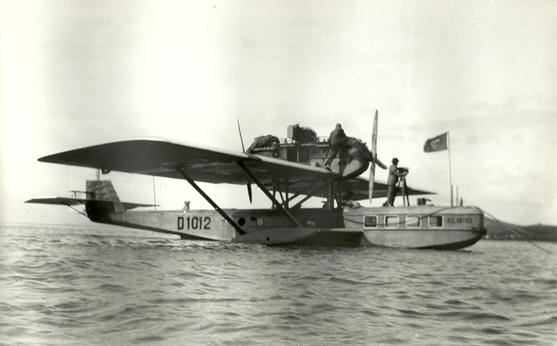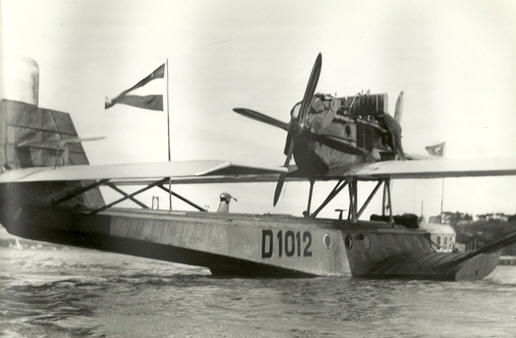
“Varig was created to serve" Otto Meyer
The creation of a Brazilian airline came in Otto Ernet Meyer Labastille’s mind, a German born in 1897, in Neider-Marschhacht, he was an aviator from Royal Prussian Aviation. He emigrated to Brazil in 1921, hired by a German company in Recife. Otto Meyer tried to create an airline in Recife and then in Rio de Janeiro, but only found the necessary support in Porto Alegre.
In 1926 he went to Germany looking for aircraft and expert staff. Otto Meyer made a deal with Condor Syndikat, a German airline: the airline would provide a plane and staff to operate the plane in exchange for 21% of the future Brazilian airline.
Condor Syndikat received authorization to fly in Brazil on January 26, 1927 and February 3, launched Brazil's first commercial flight. On May 7, 1927 “Viação Aérea Rio Grandense”, also known as VARIG, was officially established. Its first aircraft was a Dornier Wal, named "Atlântico" (Atlantic).
VARIG’s first route was known as "Linha da Lagoa” (Lagoon’s Line), linking Porto Alegre, Pelotas and Rio Grande. The flight was made at low altitude, between 20 and 50 meters, over Lagoa dos Patos (Ducks Lagoon), at a cruising speed of 160 km/h. The plane capacity was only 9 passengers. At check-in, the passenger was weighed with their luggage, and if weighed more than 75 kg he or she was charged by overweight. Were also distributed cotton and gum to all passengers. The cotton was to be put in the ears to reduce the engine’s noise and the gum to relieve the discomfort caused by pressure change. The flight lasted about two hours and 20 minutes, much faster than a train and the ticket was not much more expensive. VARIG built a ramp and some workshops on Ilha Grande dos Marinheiros island in Jacuí river, in front of Porto Alegre city, to serve as operations base.
At the end of 1927 VARIG carried a total of 668 passengers and
received its second aircraft, the Dornier Merkur, named "Gaúcho".
Gaúcho is the name given to those who were born in Rio Grande do Sul
Brazilian state. The company also acquired two Klemm L-25, but these
aircraft were not used to carry passengers, as there were only two
places in the plane: for a passenger and for the pilot. This
aircraft were used to transport mailbag and also advertisement of
commercial aviation in the inner cities of Rio Grande do Sul State.


Dornier Wal "Atlântico", VARIG’s first aircraft
/
VARIG’s station in Pelotas, where passengers wait to board,
protected from the cold



In 20’s VARIG’s passengers need to board in a boat to
get to the aircraft
|
1920s |
|
|
Fleet:
1xDornier
Wal |
Destinations:
President: |
 |
|
HOW WAS FLYING IN THE 1920s?
|


Dornier Wal "Atlântico" /
"Gaúcho": VARIG’s second plane
 |
|
IN FOCUS: Brazil's first commercial flight
|





 In
the 1920s, travel by airplane was completely new.
VARIG's challenge was to convince people that traveling
by plane was safe, comfortable and faster than other
types of transport. At that time everything was still
very primitive, starting with boarding. The passengers
were taken to the docks, to be transported by boat to
Ilha Grande dos Marinheiros, where tickets were checked.
On the ticked, the words: "For your safety, smoking is
strictly prohibited, as well as throwing objects through
the windows." Luggage and the passenger were weighing together, being surcharged if the sum surpassed
75 kilos.
In
the 1920s, travel by airplane was completely new.
VARIG's challenge was to convince people that traveling
by plane was safe, comfortable and faster than other
types of transport. At that time everything was still
very primitive, starting with boarding. The passengers
were taken to the docks, to be transported by boat to
Ilha Grande dos Marinheiros, where tickets were checked.
On the ticked, the words: "For your safety, smoking is
strictly prohibited, as well as throwing objects through
the windows." Luggage and the passenger were weighing together, being surcharged if the sum surpassed
75 kilos.
 Who
made the first flight in Brazil, Condor Syndikat or
Varig? Condor Syndikat was Brazilian or German?
Who
made the first flight in Brazil, Condor Syndikat or
Varig? Condor Syndikat was Brazilian or German?